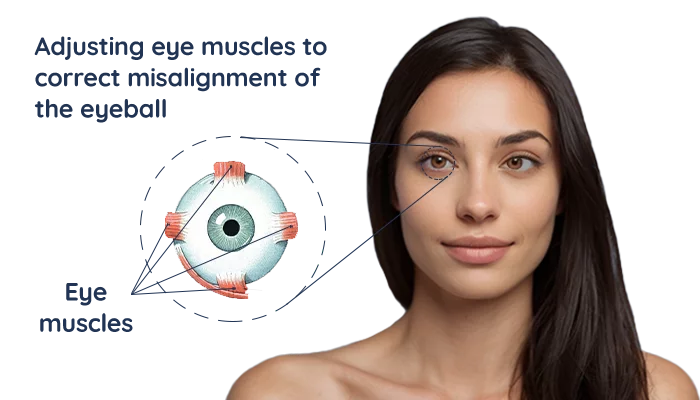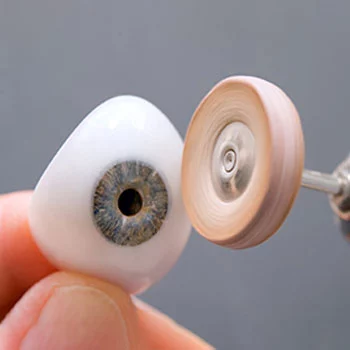What is strabismus?
Strabismus, commonly known as "crossed eyes" or "squint," is a visual condition characterized by the misalignment of the eyes. In individuals with strabismus, the eyes are not properly aligned and do not work together to focus on an object.
Types of strabismus
There are several types of strabismus, which include:
- Esotropia: In esotropia, one or both eyes turn inward towards the nose. It is the most common form of strabismus in infants and young children.
- Exotropia: Exotropia is characterized by one or both eyes turning outward away from the nose. It is also known as "wall-eyed" or "divergent strabismus."
- Hypertropia: Hypertropia refers to one eye deviating upward while the other eye maintains a straight gaze. It is less common than esotropia or exotropia.
- Hypotropia: Hypotropia involves one eye deviating downward while the other eye maintains a straight gaze. Like hypertropia, it is less common than esotropia or exotropia.
- Alternating strabismus: Alternating strabismus occurs when the eye that deviates switches between the left and right eye. For example, one eye may turn inward at times, while the other eye turns outward at other times.
- Monocular strabismus: Monocular strabismus, also known as unilateral strabismus, refers to a condition where only one eye is misaligned, while the other eye maintains proper alignment.
- Bilateral strabismus: Bilateral strabismus refers to the condition in which both eyes are misaligned or do not align properly.
It's important to note that these are general classifications, and individual cases of strabismus can vary in terms of severity, frequency of misalignment, and associated symptoms.
Symptoms of strabismus
The symptoms of strabismus can vary depending on the type and severity of the eye misalignment. Here are some common symptoms associated with strabismus:
- Misaligned or crossed eyes: The most apparent symptom of strabismus is the visible misalignment of the eyes. One eye may turn inward, outward, upward, or downward while the other eye maintains a straight gaze.
- Double vision: When the eyes are misaligned, the brain may receive conflicting visual input from each eye, resulting in double vision. This can be more noticeable when looking at objects up close or at a distance.
- Eye fatigue or strain: Strabismus can cause the eye muscles to work harder to compensate for the misalignment, leading to eye fatigue or strain. This can result in discomfort, headaches, or aching around the eyes.
- Poor depth perception: Proper eye alignment is crucial for accurate depth perception. With strabismus, the misalignment can impact depth perception, making it harder to judge distances accurately.
- Squinting or closing one eye: Some individuals with strabismus may squint or close one eye to try and improve their vision or reduce double vision.
- Poor visual acuity in one eye: In certain cases, strabismus can lead to a condition called amblyopia or "lazy eye." The brain may suppress the visual input from the misaligned eye, resulting in reduced vision in that eye.
It's important to note that some individuals with strabismus may not experience noticeable symptoms, especially if the misalignment is intermittent or mild. However, even in such cases, it is still important to seek evaluation and treatment from an eye care professional to prevent potential complications and optimize visual outcomes.
Causes of strabismus
The causes of strabismus can be attributed to various factors, including problems with the eye muscles, nerve control of the eye muscles, or issues with the brain's interpretation of visual information. Here are some common causes of strabismus:
- Weak or imbalanced eye muscles: Strabismus can occur when the muscles that control eye movement are weak or imbalanced. If one eye muscle is stronger or weaker than its counterpart, it can result in the misalignment of the eyes.
- Nerve or brain-related issues: Strabismus can also be caused by problems with the nerves that control the eye muscles or issues with the brain's ability to coordinate the movement of both eyes. Conditions such as nerve palsy, stroke, or certain neurological disorders can contribute to the development of strabismus.
- Genetics: Strabismus can run in families, suggesting a genetic predisposition. If a close family member has strabismus, there may be an increased likelihood of developing the condition.
- Refractive errors: Uncorrected refractive errors, such as nearsightedness (myopia), farsightedness (hyperopia), or astigmatism, can contribute to the development of strabismus. When the eyes struggle to focus properly, it can lead to eye misalignment.
- Eye injuries or trauma: Trauma to the eye muscles or surrounding structures can result in strabismus. Injuries that affect the nerves or cause muscle weakness can disrupt the normal alignment of the eyes.
- Other underlying eye conditions: Certain eye conditions, such as cataracts, retinopathy of prematurity (ROP), or childhood eye tumors, can increase the risk of developing strabismus.
It's important to note that the specific cause of strabismus can vary from person to person, and sometimes the exact cause may not be fully known or identifiable. A comprehensive evaluation by an ophthalmologist or a pediatric ophthalmologist is essential to determine the underlying cause of strabismus in each individual case. This can help guide appropriate treatment and management strategies.
What is strabismus repair surgery?
Strabismus surgery, also known as eye muscle surgery or squint surgery, is a surgical procedure performed to correct the misalignment of the eyes in individuals with strabismus. The surgery aims to improve eye alignment, enhance binocular vision, and improve overall visual function.
During strabismus surgery, the surgeon makes small incisions in the tissue covering the eye to access the eye muscles. The specific muscles targeted for surgery depend on the type and direction of the eye misalignment. The surgeon may weaken or strengthen the eye muscles by adjusting their position, length, or tension.
Who are candidates for strabismus surgery?
Candidates for strabismus surgery are individuals who have persistent or severe misalignment of the eyes (strabismus) that cannot be adequately corrected with non-surgical treatments or interventions. The decision to undergo strabismus surgery is made in collaboration between the patient (or their guardian) and an ophthalmologist or a pediatric ophthalmologist. Here are some factors that may make someone a candidate for strabismus surgery:
- Misalignment that affects daily functioning: If the misalignment of the eyes (crossed eyes) significantly impacts a person's ability to perform daily activities, such as reading, driving, or maintaining eye contact, strabismus surgery may be considered.
- Non-surgical treatments have been ineffective: If non-surgical treatment options, such as glasses, vision therapy, or patching, have not achieved the desired eye alignment or improved visual function, surgery may be recommended.
- Persistent or worsening misalignment: If the misalignment of the eyes persists or worsens over time despite previous treatments, surgery may be considered a more definitive solution.
- Amblyopia (lazy eye) management: Strabismus surgery may be indicated in individuals with amblyopia, especially if it is associated with a significant misalignment that is not responsive to other treatments. Surgery can help align the eyes and improve visual acuity in the amblyopic eye.
- Functional and cosmetic concerns: Strabismus surgery may be considered for individuals who are concerned about the appearance of their eyes or experience social and emotional challenges due to the misalignment. Surgery can help improve eye alignment and enhance cosmetic appearance.
It's important to note that the decision to undergo strabismus surgery is individualized and based on a comprehensive evaluation by an ophthalmologist or a pediatric ophthalmologist. They will consider factors such as the type and severity of strabismus, the individual's age, overall eye health, and personal goals. The potential risks, benefits, and expected outcomes of the surgery will be discussed with the patient or their guardian to make an informed decision.
How is the strabismus surgery performed?
Strabismus surgery is typically performed by an ophthalmologist or a pediatric ophthalmologist who specializes in eye muscle surgery. The surgical procedure involves several steps, which can vary depending on the specific type and severity of strabismus. Here is a general overview of how strabismus surgery is performed:
- Anesthesia: Strabismus surgery is usually performed under general anesthesia, especially in children, to ensure comfort and immobility during the procedure. Local anesthesia with sedation or regional anesthesia may also be considered in certain cases.
- Incisions: The surgeon begins by making small incisions in the conjunctiva, which is the clear tissue covering the white part of the eye (sclera). These incisions allow access to the eye muscles that need to be adjusted.
- Muscle adjustment: After identifying the specific eye muscle(s) responsible for the misalignment and determining the appropriate surgical technique (see next section), the surgeon makes necessary adjustments to the muscle(s).
- Suture placement: After adjusting the eye muscle(s), the surgeon secures them in their new position using sutures (stitches). The sutures may dissolve on their own over time or may need to be removed during a follow-up visit.
- Closure: The incisions in the conjunctiva are closed using small sutures that will dissolve on their own or with tissue glue. In some cases, a temporary patch or shield may be placed over the eye to protect it during the initial healing phase.
The duration of the surgery can vary depending on the complexity of the case, the number of muscles involved, and the chosen surgical technique. It typically takes about 30 minutes to an hour to complete the procedure.
Strabismus surgery techniques
The most common techniques used in strabismus surgery are as follows:
- Recession: In recession surgery, the eye muscle(s) responsible for pulling the eye in the wrong direction are weakened. The surgeon detaches the muscle(s) from the eye and reattaches them farther back on the eye, reducing their pulling power. This helps to align the eyes by allowing the opposing muscles to regain control.
- Resection: In resection surgery, a portion of the eye muscle(s) responsible for pulling the eye in the wrong direction is removed. The remaining ends of the muscle(s) are then reattached, shortening the muscle and increasing its pulling power. This technique helps to align the eyes by strengthening the opposing muscles.
- Adjustable Sutures: Adjustable sutures are used in certain cases to allow for fine-tuning of eye alignment during or after the surgery. The sutures are temporarily left long, and the alignment is assessed while the patient is awake. If necessary, the surgeon can make adjustments by tightening or loosening the sutures until the desired alignment is achieved. Once the alignment is satisfactory, the sutures are secured in their final position.
- Faden Operation: In a faden operation, also known as a posterior fixation suture, the eye muscle is partially detached and reattached further back on the eye, but not completely recessed or resected. This technique limits the muscle's range of movement, reducing the misalignment. It is often used for certain types of strabismus associated with abnormal muscle function.
- Transposition Procedures: Transposition procedures involve transferring the attachment of an eye muscle to a different location on the eye or to another eye muscle. This technique can be used in complex cases of strabismus or when the usual recess or resection approach is not suitable.
- Hang-Back Technique: The hang-back technique involves reattaching the muscle to the eye using a suture that is anchored further back on the eye than the original insertion point. This technique can be useful for adjusting the tension and position of the muscle during surgery.
The choice of technique depends on various factors, including the specific type of strabismus, the severity of the misalignment, and the surgeon's expertise. The surgeon will evaluate the individual's condition, discuss the available options, and determine the most appropriate technique to achieve the best possible alignment and visual function.
How to prepare for the surgery?
Preparing for strabismus surgery involves several important steps to ensure a smooth and successful procedure. Here are some general guidelines to help you prepare:
- Consultation with the surgeon: Schedule a consultation appointment with the ophthalmologist or pediatric ophthalmologist who will perform the surgery. During this visit, the surgeon will evaluate your condition, discuss the surgical plan, and address any concerns or questions you may have.
- Medical evaluation: Provide the surgeon with a complete medical history, including any past eye conditions, surgeries, or allergies. Inform them about any medications you are currently taking, as some medications may need to be adjusted or temporarily stopped before the surgery.
- Pre-operative testing: Depending on your case, the surgeon may order specific pre-operative tests, such as eye measurements, vision testing, or imaging scans, to gather more information about your eyes and guide the surgical plan.
- Medication instructions: Follow any instructions provided by the surgeon regarding medication use before the surgery. This may include stopping certain medications, such as blood thinners, a few days before the surgery to reduce the risk of bleeding during the procedure.
- Fasting instructions: Follow the fasting instructions provided by the surgeon or the surgical center. Typically, you will be asked to avoid eating or drinking anything for a certain period before the surgery, usually starting from midnight the night before the procedure. This is to ensure an empty stomach and reduce the risk of complications under anesthesia.
- Arrange transportation: Since strabismus surgery is usually performed under general anesthesia, arrange for someone to drive you home after the procedure. It is generally not safe to drive immediately after anesthesia.
- Personal preparations: On the day of the surgery, wear comfortable clothing and avoid wearing makeup, contact lenses, or any accessories around the eyes. Remove any nail polish or jewelry from your hands and wrists.
- Caregiver support: If the surgery is for a child or if you require assistance, arrange for a caregiver or family member to accompany you to the surgery and provide support during the recovery period.
- Follow pre-operative instructions: Follow any additional instructions provided by the surgeon or the surgical center, such as showering the night before or using specific eye drops.
It is essential to communicate openly with your surgeon, follow their instructions, and address any concerns you may have before the surgery. This will help ensure that you are adequately prepared and have a successful surgical experience.
What is the recovery like?
The recovery process after strabismus surgery can vary from person to person, but here are some general aspects of what to expect during the recovery period:
- Immediate post-operative period: After the surgery, you will typically spend some time in a recovery area where medical staff will monitor your vital signs. Your eyes may be covered with a patch or protective shield to prevent accidental rubbing or injury. Some individuals may experience mild discomfort, redness, or swelling around the eyes, which is normal and should gradually subside.
- Medications and eye care: The surgeon may prescribe eye drops or ointments to aid in healing, reduce inflammation, and prevent infection. It is important to follow the prescribed medication regimen and any specific instructions for eye care, such as how to clean the eyes or administer eye drops.
- Rest and recovery: It is important to allow your eyes to rest and recover following surgery. Avoid activities that strain the eyes, such as reading, watching screens, or participating in strenuous physical activities for the first few days or as advised by your surgeon.
- Follow-up appointments: You will have follow-up appointments with your surgeon to monitor the progress of healing, assess eye alignment, and make any necessary adjustments. These appointments are crucial for evaluating the success of the surgery and addressing any concerns or complications that may arise.
- Gradual improvement: Over time, you should notice a gradual improvement in eye alignment and visual function. It may take several weeks or even months for the full benefits of the surgery to become apparent. It's important to have realistic expectations, as perfect eye alignment and complete resolution of symptoms may not always be achieved.
- Resuming normal activities: The timeline for resuming normal activities will vary depending on the individual and the specific instructions provided by your surgeon. In general, most individuals can gradually return to their usual activities, including work or school, within a few days to a couple of weeks.
It's important to follow all post-operative instructions provided by your surgeon, attend all scheduled follow-up appointments, and communicate any concerns or changes in your condition during the recovery period. This will ensure that your recovery progresses smoothly and any potential issues can be addressed promptly.
How much does strabismus surgery cost?
The cost of strabismus surgery can vary widely depending on various factors, including the geographical location, the specific surgeon or medical facility, the complexity of the case, and the type of insurance coverage, if applicable. It is important to note that the following information provides a general overview and actual costs can significantly differ.
In the United States, the average cost of strabismus surgery can range from $2,000 to $8,000 per eye. This cost typically includes the surgeon's fees, anesthesia fees, facility fees, pre-operative evaluations, post-operative care, and follow-up appointments. However, it is important to inquire about the specific breakdown of costs with your healthcare provider or surgeon to have a clear understanding of what is included.
It is also worth noting that insurance coverage can significantly impact the out-of-pocket expenses for strabismus surgery. Some insurance plans cover a portion or all of the expenses for medically necessary strabismus surgery, especially if it is affecting vision or causing functional impairment. However, coverage policies can vary, and it is recommended to contact your insurance provider to understand the details of your coverage, including any deductibles, copayments, or limitations.
For individuals without insurance coverage or with limited coverage, there may be options available to discuss payment plans or explore financial assistance programs offered by healthcare providers or charitable organizations.
It is important to consult with your ophthalmologist or pediatric ophthalmologist to obtain a personalized estimate of the cost of strabismus surgery based on your specific situation and location. They can provide more accurate information regarding the potential costs involved and help navigate insurance coverage, if applicable.
What are the potential risks and side effects of strabismus surgery?
Like any surgical procedure, strabismus surgery carries certain risks and potential side effects. It is important to discuss these with your ophthalmologist or pediatric ophthalmologist before undergoing the surgery. Here are some potential risks and side effects associated with strabismus surgery:
- Infection: There is a small risk of developing an infection at the surgical site. Precautions are taken to minimize this risk, including the use of sterile techniques and antibiotics. If you notice increasing redness, pain, or discharge from the eye after surgery, it is important to contact your surgeon promptly.
- Bleeding: Although rare, there is a risk of bleeding during or after the surgery. Your surgeon will take precautions to minimize this risk, and any bleeding that occurs can usually be controlled. However, excessive bleeding may require additional intervention.
- Scarring: Strabismus surgery involves making incisions in the conjunctiva, which may result in some scarring. In most cases, any scarring is minimal and not visually significant. However, in rare cases, excessive scarring can affect eye movement or alignment.
- Overcorrection or under-correction: The goal of strabismus surgery is to achieve optimal eye alignment. However, there is a possibility of overcorrection. In such cases, additional surgery or other treatments may be necessary.
- Residual misalignment: In some instances, despite a successful surgery, there may be residual misalignment or a recurrence of strabismus over time. This can occur due to various factors, such as changes in muscle function or growth. Additional treatments or monitoring may be required to manage any residual misalignment.
- Double vision: Following strabismus surgery, some individuals may experience temporary or, in rare cases, persistent double vision. This can occur if the brain is not able to fuse the images from both eyes properly. Vision therapy or other interventions may be recommended to help manage this symptom.
- Anesthesia risks: Strabismus surgery is typically performed under general anesthesia, which carries its own set of risks. These risks can include allergic reactions, breathing difficulties, or reactions to anesthesia medications. Anesthesia-related risks are generally minimal but can be more significant in individuals with certain medical conditions.
It is important to remember that the majority of strabismus surgeries are successful, and complications are relatively rare. Your surgeon will discuss potential risks and side effects with you, answer any questions you may have, and provide guidance on how to minimize these risks. By carefully following pre-operative and post-operative instructions, attending all follow-up appointments, and communicating any concerns with your surgeon, you can help ensure a smooth recovery with the best possible outcome.
Non-surgical treatments for strabismus
Strabismus can be corrected without surgery in some cases, especially if it is detected early and the misalignment is not severe. Non-surgical treatment options are often explored first, depending on the underlying cause and individual circumstances. Here are some non-surgical approaches that may be used to correct strabismus:
- Eyeglasses or contact lenses: Corrective lenses can help address any refractive errors that may be contributing to the misalignment. By providing clear vision, they can sometimes help improve eye alignment.
- Vision therapy: Vision therapy involves a series of exercises and activities designed to improve eye coordination and strengthen eye muscles. It aims to train the eyes to work together and improve alignment. Vision therapy is often used, especially in children, to improve eye coordination and alignment.
- Prism lenses: Special lenses, called prism lenses, can be prescribed to modify the way light enters the eyes and help align the images seen by each eye. Prism lenses can be particularly effective for individuals with mild to moderate misalignment.
- Patching or atropine eye drops: If amblyopia (lazy eye) is present, patching or atropine eye drops may be used to encourage the weaker eye to work harder and improve visual acuity. By covering the stronger eye or temporarily blurring its vision, it helps stimulate the weaker eye.
- Botox injections: In some cases, botulinum toxin (Botox) injections may be used to temporarily weaken specific eye muscles, allowing for better alignment. This approach is typically used in certain types of strabismus or as a temporary measure before considering surgery.
It's important to note that the success of non-surgical treatments for strabismus depends on factors such as the individual's age, the severity and type of strabismus, and the underlying cause. In some cases, surgery may still be necessary to achieve optimal eye alignment and improve visual function. Consulting with an ophthalmologist or a pediatric ophthalmologist is crucial to determine the most appropriate treatment plan tailored to each individual's needs.
FAQs
What is the best age for strabismus surgery?
Strabismus surgery can be performed at any age, depending on the individual's specific circumstances. However, in general, the optimal age for strabismus surgery is typically between 1 and 6 years old. During this period, the visual system is still developing, and early intervention can help prevent or minimize long-term vision problems and improve the chances of achieving good eye alignment and binocular vision. However, strabismus surgery can also be performed successfully in older children, teenagers, and adults. The timing of the surgery will depend on factors such as the severity of the strabismus, the presence of amblyopia (lazy eye), the ability to achieve binocular vision, and the individual's overall health.
Can strabismus come back after surgery?
Strabismus can occasionally recur after surgery, although it is not common. The term used for the recurrence of strabismus after surgery is "strabismus reoperation" or "strabismus recurrence." The likelihood of strabismus coming back after surgery can depend on several factors including the surgical technique, severity of strabismus, underlying causes, individual healing responses, and developmental changes (in children).
Can you have strabismus in both eyes?
Yes, it is possible to have strabismus in both eyes. While strabismus can affect one eye (unilateral strabismus), it can also occur in both eyes (bilateral strabismus).
Can strabismus in one eye affect the other eye?
Yes, strabismus in one eye can affect the other eye by causing visual suppression, disrupting binocular vision, straining the non-deviating eye, and increasing the risk of developing strabismus in the other eye.





